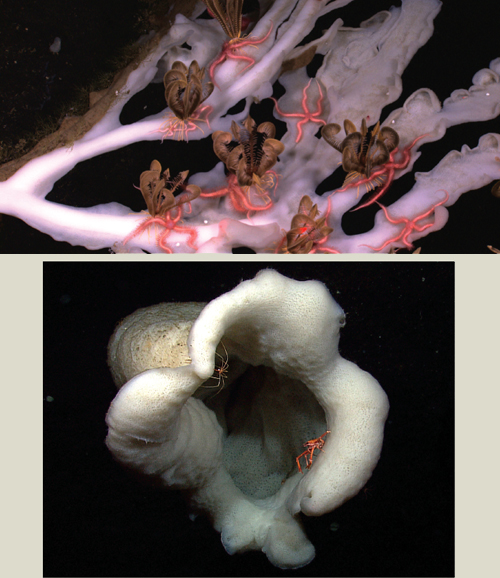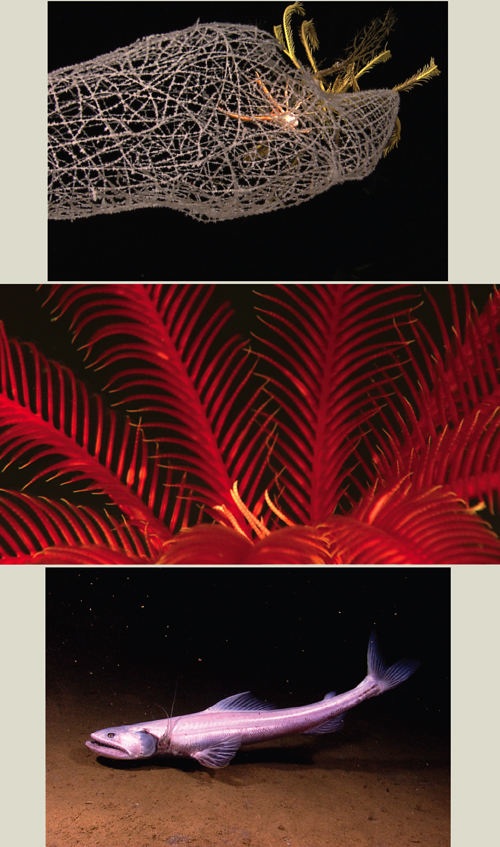Probing Deep-Sea Domains Off Indonesia
By Catherine Clabby
The ship Okeanos Explorer brings back images of creatures rarely seen
The ship Okeanos Explorer brings back images of creatures rarely seen

DOI: 10.1511/2011.89.152
In the summer of 2010, the National Oceanic and Atmospheric Administration (NOAA) and Indonesia together explored the deep sea near that archipelago nation. The region’s land and shallow seas are among the planet’s most biologically diverse, but much of the nearby deep water was a mystery. Two ships, NOAA’s Okeanos Explorer and the Indonesian Baruna Jaya IV, mapped nearly 40,000 square kilometers and discovered underwater volcanic features such as cones, rift zones and craters. Sensors profiled water columns and currents, including chemical signatures of hydrothermal vents. An unmanned vehicle fitted with cameras photographed marine life, including multiple species that may be new to science. Stephen Hammond, the mission’s chief scientist, briefed American Scientist associate editor Catherine Clabby on the research.

Images courtesy of NOAA Okeanos Explorer Program, INDEX-SATAL 2010.
A.S. Part of the government’s motivation for this expedition was President Obama’s desire to give U.S. scientists more of a chance to collaborate with researchers from a Muslim-majority country. But there were multiple scientific reasons, weren’t there?
S.H. Yes. Indonesian seas lie at the heart of the Coral Triangle, an area that includes habitat for hundreds of coral species and thousands of fish species. Also, ocean currents through the area connect the Pacific and Indian oceans and play a role in the global distribution of heat and nutrients—important to understanding both climate change and the distribution and sustenance of the region’s many ecosystems. And the area’s geologic complexity gives rise to a great many volcanoes. We know from the past several decades of ocean exploration that such localities frequently host very unusual ecosystems characterized by animals that subsist through utilization of the chemical compounds contained in hydrothermal vent fluids.
A.S. What were some of the newer instruments or technologies that made it possible to explore the deep waters near Sangihe and Talaud, two Indonesian island chains?
S.H. A state-of-the-art, high-resolution swath sonar system on the hull of the Okeanos Explorer produced very detailed bathymetric maps. These maps made it possible to identify areas of particular interest for detailed observations using a remotely operated vehicle (ROV). Secondly, we had the means to transmit high-definition video over satellites from the sea floor to shore-based exploration command centers. From there, U.S. and Indonesian government and university scientists helped direct the expedition in real time.

Images courtesy of NOAA Okeanos Explorer Program, INDEX-SATAL 2010.
A.S. Little Hercules dived 27 times and as deep as 3,640 meters while collecting hundreds of hours of video. What was some of the most interesting sea life recorded?
S.H. The geology, and thus the seafloor bathymetry, of the Indonesian region, is very complex. Depths range from shallow reefs within the zone where light penetrates to perpetually dark trench areas with depths in excess of 9 kilometers. What is most interesting depends greatly on the expertise and interests of the observer. In broad terms, however, the very robust ecosystem thriving within the active hydrothermal system on Kawio Barat volcano is fascinating because of the presence of large numbers of (likely chemotrophic) animals clustered close to vigorously venting plumes of magma-heated water and minerals. Also fascinating were the large numbers and never-before-seen diversity and abundance of deep corals. Biologists participating in the expedition estimate that at least several tens of new deep-sea coral species were observed. Likewise, many likely new species of benthic and deep-dwelling organisms were observed, including sea spiders, holothurians (sea cucumbers) and fish. Data from this expedition will be of use not only in expanding our knowledge of the numbers and kinds of animals living in deep Indonesian seas, they will provide new and likely critical information concerning the flow of deep currents and their roles in changing global climate patterns.
In Sightings, American Scientist publishes examples of innovative scientific imaging from diverse research fields.
Click "American Scientist" to access home page
American Scientist Comments and Discussion
To discuss our articles or comment on them, please share them and tag American Scientist on social media platforms. Here are links to our profiles on Twitter, Facebook, and LinkedIn.
If we re-share your post, we will moderate comments/discussion following our comments policy.